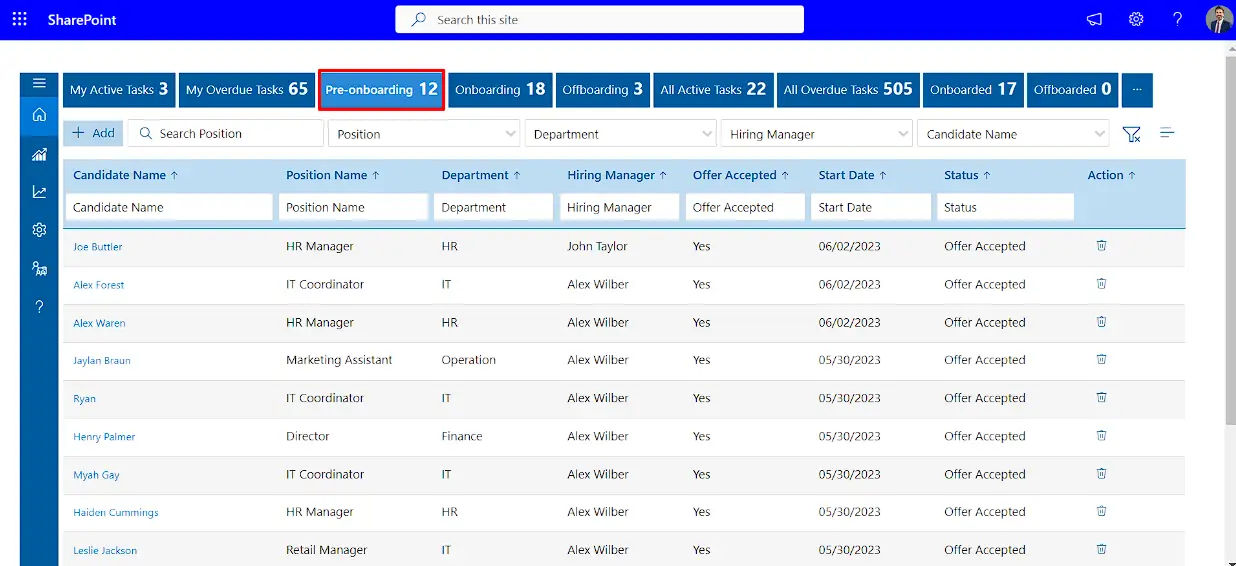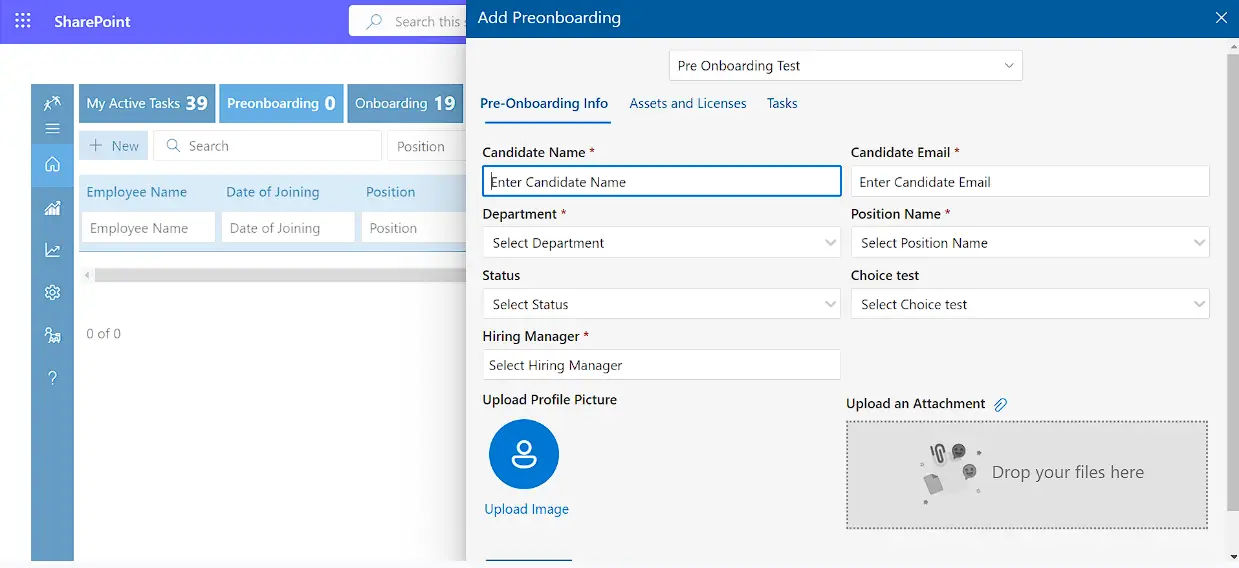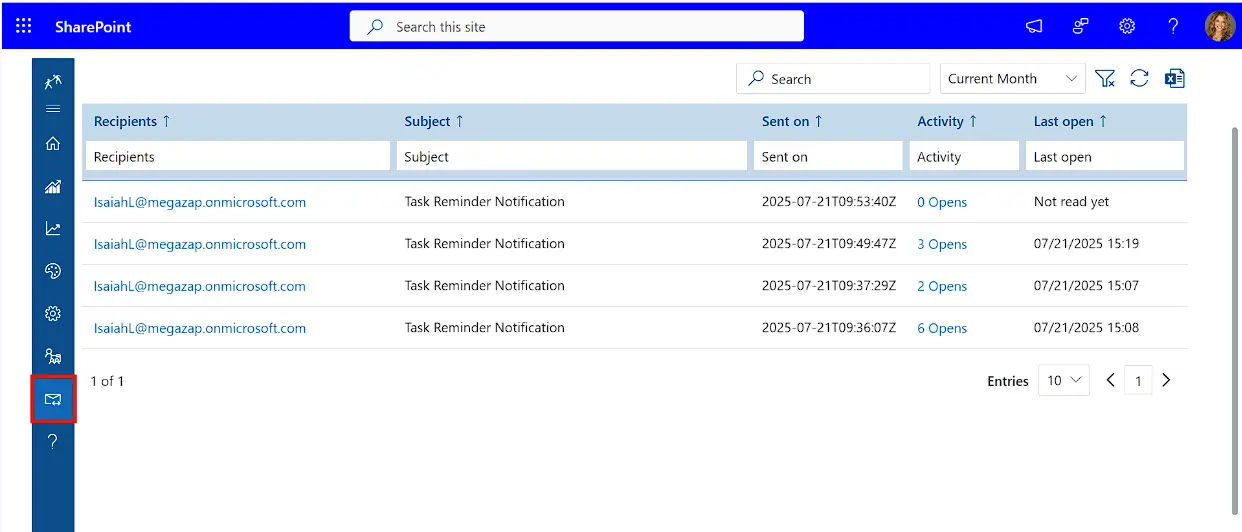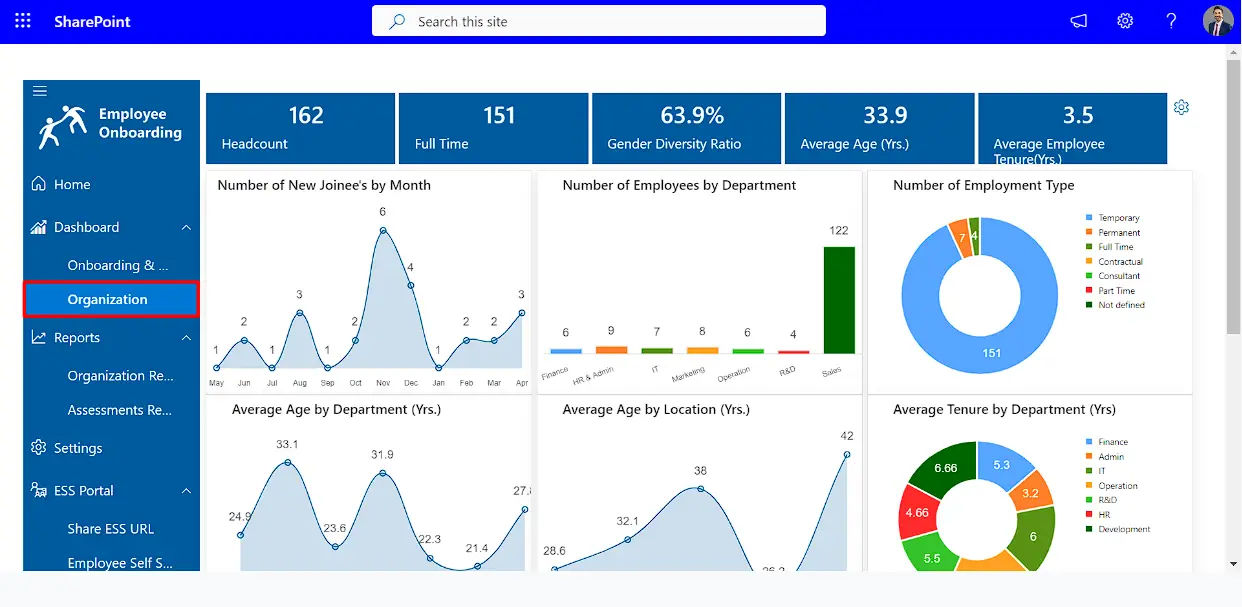_UlD2_kHqwz.webp)
Starting a new job should be exciting, yet for many employees today, it begins with a login screen instead of a warm welcome. With the rise of remote and hybrid work, companies now rely on Employee Onboarding Software to create that first impression and guide new hires into their roles.
✨
Quick Read
Summary generated by AI, reviewed for accuracy.
The online onboarding process digitally welcomes and trains new employees, ensuring they feel prepared and supported from day one.
It boosts engagement, retention, and productivity while providing a consistent, scalable, and human-centered experience.
As per CIPD report by 2025, flexible work has become standard practice, with 74% of organizations worldwide adopting remote or hybrid work models. However, while work environments have evolved, onboarding practices have often lagged. Many new employees still encounter lack of communication in their crucial first days, especially in a remote work onboarding process where digital tools and clear communication become even more essential.
This challenge presents an opportunity to create a more engaging and meaningful experience. Strong Onboarding Solutions can ensure new hires feel valued, supported, and ready to succeed from day one. Whether you’re leading a small team or scaling a growing company, this guide will share practical steps to make your online onboarding process faster, smoother, and more human in today’s digital workplace.
What is Online Onboarding Process?
The online onboarding process is the structured way organizations welcome and integrate new employees in a digital-first workplace. Instead of walking into an office for handshakes and desk tours, new hires now begin their journey from laptops often connecting from different cities, time zones, or even countries.
This process goes beyond simply giving access to a work account. It’s about ensuring employees feel confident, informed, and supported from the very first day. Online onboarding typically involves sending personalized welcome messages, sharing company culture and policies, setting up training modules, arranging virtual introductions with colleagues, and providing access to all necessary systems and resources.
A strong new employee onboarding experience ensures consistency, builds engagement, and helps every hire feel connected to the organization from the start. From scheduling video orientations to assigning tasks and tracking progress, the online process ensures nothing is missed and every employee feels included.
Key Stages of the Online Onboarding Process
A well-designed online onboarding process helps new employees feel confident, prepared, and truly connected even before their first official day. In today’s digital-first workplace, every step matters. It’s not just about tasks, but about creating a sense of belonging that lasts. Here are the ten most important stages to focus on:
1. Preboarding

Onboarding begins the moment a candidate accepts your offer. Send a warm welcome email and share essentials like the start date, point of contact, and expectations. Provide access to communication platforms and early resources. Showing that everything is ready makes new hires feel excited and valued.
2. Paperwork and Setup

Streamline forms such as tax documents, ID checks, and agreements by making them digital. Ensure accounts, tools, and email are set up before Day One. A smooth setup builds confidence and eliminates first-day delays.
3. First Day Experience
The first day should feel welcoming, not overwhelming. Host a virtual meet-and-greet, introduce managers and teammates, and walk through the first week’s schedule. Assigning a buddy for support helps reduce anxiety and builds trust early.
Also Read: How Long Does It Take to Onboard a New Employee
4. Orientation and Company Introduction
Share your company’s story, mission, and values through engaging videos, presentations, or live sessions. Giving new hires a clear picture of the organization strengthens their sense of purpose and motivation.
5. Role-Based Training
Once employees understand the big picture, shift to role-specific learning. Offer training modules, practical tasks, and a 30-day plan with achievable goals. Clear training ensures they know what success looks like in their role.
6. Feedback and Check-Ins
Frequent conversations are essential. Schedule weekly check-ins during the first month to discuss progress, answer questions, and gather feedback on the onboarding process itself. This prevents small concerns from becoming larger issues.
7. Cultural and Social Integration
Remote employees can feel isolated, so create opportunities for informal connections. Organize virtual coffee chats, team-building sessions, or fun icebreakers. Encourage new hires to share personal interests to build stronger bonds.
8. Technology Familiarization
Introduce employees to all the digital platforms they’ll use daily. Provide guides, walkthrough videos, or live demos of project management tools, communication apps, and other resources. Using Onboarding Software for Remote Workers can centralize these steps, making it easier for new hires to learn and adopt tools without confusion.
9. Performance Expectations and Milestones
Clearly outline short-term and long-term performance goals. Set milestones for the first 30, 60, and 90 days, so employees know what’s expected of them. Transparent expectations create clarity and reduce stress.
10. Long-Term Growth and Development
Onboarding doesn’t end after the first month. Introduce learning opportunities, mentorship programs, and career development resources early on. Showing a path for growth motivates employees to stay engaged and loyal.
Importance of Online Onboarding Process
In today’s digital-first workplace, the onboarding journey sets the tone for how employees feel about their new role and the organization. A strong online onboarding process not only saves time and resources but also ensures employees feel welcomed, engaged, and prepared to succeed. Below are ten key reasons why the online onboarding process is vital for organizations of all sizes.
1. Faster Integration into Company Culture
Online onboarding helps employees quickly understand organizational values and behaviours. With digital access to resources, videos, and culture guides, they feel connected from day one. This accelerates cultural alignment and builds confidence.
2. Improved Efficiency and Productivity

A streamlined onboarding process eliminates repetitive manual tasks. Digital tools allow employees to complete forms, training, and compliance steps in one place. This enables them to focus on core responsibilities sooner, boosting productivity.
3. Consistency Across All Hires
Every new employee deserves a clear and standardized onboarding experience. Online platforms ensure uniformity, preventing information gaps or confusion. This creates fairness and transparency across departments and roles.
4. Enhanced Employee Engagement
Interactive learning modules, gamification, and multimedia training make onboarding engaging. Employees are more likely to retain information when it’s delivered dynamically. Higher engagement translates into stronger motivation and early contribution.
5. Better Tracking and Measurement
With digital systems, HR teams can easily monitor progress and completion rates. By leveraging Onboarding Metrics, organizations gain insights into what works and what needs improvement. This data-driven approach ensures continuous refinement.
6. Flexibility for Remote and Hybrid Teams
The rise of remote and hybrid work makes online onboarding essential. Employees can access resources and complete training from anywhere in the world. This flexibility ensures inclusivity and efficiency for a distributed workforce.
7. Stronger Compliance and Documentation
Digital onboarding ensures policies, contracts, and compliance documents are securely stored. Automated reminders reduce the risk of missed steps. This strengthens organizational governance and minimizes legal risks.
8. Boost in Retention Rates
A thoughtful onboarding journey shows employees they are valued. When companies invest in a structured new hire onboarding experience, it reduces early turnover. Employees who feel supported are more likely to stay long term. As per a 99Firms report, a strong onboarding program can improve employee retention by up to 82%.
9. Smooth Role Transition
Clarity is key during the first few weeks. Online onboarding defines responsibilities, expectations, and performance goals clearly. Employees step into their roles with confidence, reducing uncertainty and stress.
10. Positive First Impression of the Company
Employee onboarding process is often the first real interaction employees have with the company. A well-designed digital experience demonstrates professionalism and care. This builds trust and loyalty from the start.
Benefits of a Strong Online Onboarding Process
Effective onboarding plays a crucial role in shaping employee success.
As per Deel, it can improve new hire retention by 82% and boost productivity by over 70%. A well-planned online onboarding process is not just helpful it is a strategic advantage. It creates a positive experience for employees while driving long-term business results.
1. Faster Time to Productivity
New hires get the information, tools, and training they need without delay.
- Employees can begin contributing to projects sooner
Less time is lost waiting for logins or wondering what to do next.
When new hires know what’s expected, they find their rhythm faster and feel more in control.
2. Higher Employee Engagement
A structured start builds trust and motivation early on.
When employees feel truly connected, they care more about their work and take pride in what they do.
- Better connection to the company’s mission and goals
- Increased willingness to collaborate and contribute
3. Reduced Turnover and Hiring Costs
Effective onboarding helps new employees feel supported and stay longer. High turnover can significantly increase the cost of onboarding a new employee, which is why creating a supportive experience from day one is essential.
- Lower risk of early resignations due to confusion or isolation
- You save time and resources by keeping great people, instead of constantly starting over with someone new.
- Greater loyalty and job satisfaction from day one
4. Stronger Company Culture
Onboarding introduces new hires to your values and team dynamics.
- Builds alignment across remote and hybrid teams
- Reinforces your company’s tone, style, and work ethic
- It gives new team members a real chance to feel included and understand how things work beyond just their job.
Also Read: – Benefits of an Online Onboarding System for HR Teams
5. Better Compliance and Consistency
Digital onboarding allows companies to standardize critical steps.
- Ensures every hire gets the same quality experience
- Makes it easier to track form completion, training status, and policies
- Reduces the risk of missing important legal or operational details
6. Scalable and Cost-Effective
Online onboarding grows with your team, without the need for physical space.
- It takes repetitive tasks off the plates of HR and managers, giving them more time to focus on people, not paperwork.
- Reduces onboarding costs like travel, printed materials, or venues
- Can be easily updated or expanded as your business evolves
7. Improved Communication and Collaboration
Online onboarding platforms encourage regular check-ins and virtual introductions.
This creates open communication channels that make teamwork easier from the start.
- Builds stronger relationships among team members
- Enhances communication across remote and hybrid teams
- Encourages collaboration from the very first week
A connected start helps employees feel like part of the team right away.
8. Enhanced Learning and Development Opportunities
Employees gain access to structured training modules and resources.
This ensures every new hire has the chance to build skills and grow quickly.
- Promotes continuous learning from day one
- Makes skill development easy to track and measure
- Helps employees grow into their roles more effectively
This focus on growth boosts confidence and career development early on.
9. Positive First Impressions of the Company
A smooth onboarding experience shapes how new hires view the organization.
It reassures employees that they’ve joined a supportive and forward-thinking workplace.
- Demonstrates professionalism and care
- Increases confidence in their decision to join
- Builds long-term trust and loyalty
First impressions matter, and onboarding sets the tone for the future.
10. Data-Driven Insights for HR
Digital onboarding provides valuable metrics for improvement.
With real-time data, HR can quickly adapt and optimize onboarding strategies.
- Tracks progress and completion rates with ease
- Identifies strengths and gaps in the onboarding journey
- Helps HR teams refine the process for future hires
with data at hand, HR can create smarter, more effective onboarding strategies.
Best Practices for Online Onboarding

1. Personalize the Experience
Avoid a one-size-fits-all approach. Customize the onboarding journey based on the employee’s role, department, and location. A sales executive will need a different onboarding experience than a software developer. Using a Employee Onboarding Checklist with personalized welcome messages and training paths can make a big difference in how engaged they feel.
2. Use Technology Wisely
Make the most of digital tools. Use video calls to build real connections, online courses to guide their learning, and simple tools to keep everything on track. The right technology makes onboarding smoother and more interactive.
3. Maintain Consistency Across Teams
Even if different departments handle onboarding differently, the core experience should remain consistent. Each new hire deserves the same care, tools, and direction because feeling supported should never depend on who you are or where you start.
A clear, consistent process helps everyone feel seen and included from day one.
4. Communicate Clearly and Often
Remote employees cannot walk over to ask questions, so communication is key. Set up regular check-ins, use chat tools like Microsoft Teams, and create clear timelines. Keeping new hires informed helps reduce anxiety and confusion.
5. Gather Feedback Continuously
Ask new hires how they felt about the onboarding process not just at the end, but during each stage. Their input helps you improve your system and fix gaps. Simple pulse surveys or one-on-one conversations can reveal valuable insights.
6. Provide Role-Specific Training
Generic onboarding is not enough employees need guidance tailored to their specific job. Offering role-based training modules, mentorship programs, and resources ensures they can perform with confidence. This also reduces the time it takes to become fully productive.
7. Foster Social Connections
Starting a new job remotely can feel isolating. Organize virtual coffee chats, team-building sessions, or buddy systems to help new hires connect with colleagues. Building these early relationships makes employees feel like part of the team from day one.
8. Monitor Progress and Celebrate Milestones
Track each stage of the onboarding journey to ensure nothing is missed. Recognize achievements like completing training modules or finishing the first project. Celebrating small wins keeps employees motivated and reinforces their sense of belonging.
Measuring Success: How to Know If Your Onboarding Is Working

Getting onboarding right is just the beginning it is what you do next that shapes the employee’s journey. You need to track how well it works so you can keep improving. From the very first touchpoint, like a new employee onboarding email, to long-term performance, each stage provides insights into success. Here are the keyways to measure it:
- Employee Retention Rates
Look at how many new hires stay beyond their first 3 to 6 months. A good onboarding process can reduce early resignations. If you see people leaving quickly, it might be time to review your approach. Retention is the clearest sign of whether onboarding builds loyalty.
- Time to Productivity
Measure how quickly new hires start performing their tasks independently. Shorter ramp-up times mean your onboarding process is doing its job by preparing them well. The faster employees contribute, the greater the business impact.
- Employee Satisfaction Scores
Use surveys to ask how satisfied new hires are with their onboarding experience. Ask questions like: Did you feel supported? Was the process clear? Were the tools helpful? High satisfaction usually means your process is on track. Happy employees are more likely to stay and thrive.
- Goal Achievement
Set simple goals for the first 30, 60 and 90 days. Track if new hires are meeting those goals. If many are falling short, it could mean they need more training or clearer expectations. Early goal success boosts confidence and engagement.
- Manager Feedback
Ask managers how prepared their new team members are after onboarding. Their insights can help you adjust your process to better meet job-specific needs.
Managers see performance impact firsthand, making their input vital.
- Engagement and Participation
Monitor how engaged new hires are in training sessions, team meetings, and digital platforms. High participation means they are interested and involved a great sign of onboarding success. Engagement shows how well employees are connecting with the company.
- Onboarding Completion Rate
Track how many new hires complete the full onboarding process including training modules, feedback forms, and introductions. If completion rates are low, it may signal that the process is too long or not engaging enough. Completion ensures consistency and readiness across all new hires.
Conclusion
In 2026, the online onboarding process is more than a formality it is a foundation for building engaged, productive, and loyal teams. From preboarding to long-term development, every step shapes the employee experience and strengthens retention.
With the right tools and strategy, you can transform onboarding into a seamless, human-centred journey that drives real business results. To see how it works in practice, Book a Demo and start creating a smarter onboarding experience today.
Join Our Creative Community
Frequently Asked Questions
What is an online onboarding process and why is it important in 2026?
An online onboarding process is a digital way to welcome, train, and connect new employees using tools like video calls, portals, and training platforms. In 2026, it ensures remote and hybrid workers feel prepared and included even before their first day. This approach makes onboarding flexible and scalable for modern workplaces.
How does a strong employee onboarding process improve retention?
A well-planned employee onboarding process helps new hires feel supported and confident from day one, reducing early resignations and building long-term retention. It also fosters loyalty by giving employees a clear path to success.
What are the key stages in an effective onboarding process?
An onboarding process typically includes preboarding, paperwork and setup, orientation, role-based training, cultural integration, and regular check-ins to make employees feel connected and job-ready. Covering all these stages creates a consistent and structured experience.
How can I measure the success of my employee onboarding process?
The success of an employee onboarding process can be measured by tracking retention rates, time to productivity, completion rates, and feedback from both employees and managers. These insights highlight strengths and show areas where improvements are needed.
Can I personalize the online onboarding process for different roles?
Yes, an online onboarding process can be tailored to specific job roles so that employees learn only what’s relevant, making training more efficient and effective. Personalization ensures employees quickly gain the skills that matter most to their position.


_mVFFaHUZhS.webp)


_JiluXJRGNl.svg)



















